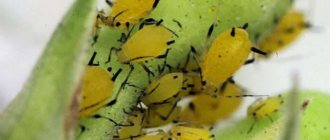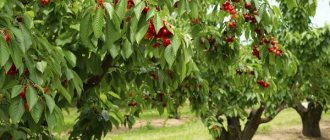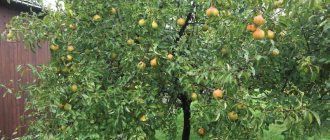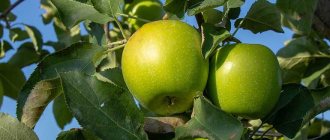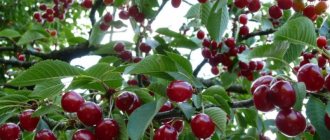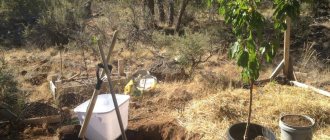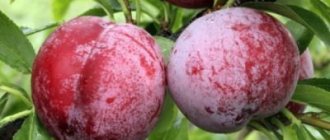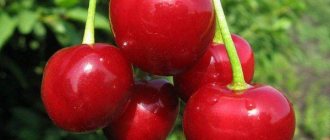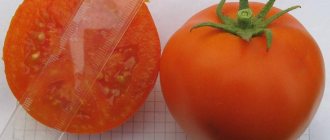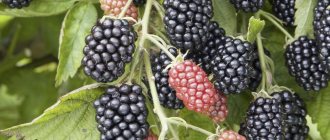History of selection
This cherry variety was bred by Ukrainian breeders at the Institute of Irrigated Horticulture (Melitopol). The authorship belongs to Turovtsev N.I. It was obtained by pollinating the Napoleon white variety with a mixture of pollen from 12 different varieties of cherries.
The variety has undergone state variety testing since 1984. Recommended for the North Caucasus region and the Astrakhan region, but due to its frost and drought resistance it can also be grown in other areas. In Ukraine, the variety is zoned in the steppe zone.
Sweet cherry summer resident description of the variety photo reviews
Latin name: prunus avium 'dachnica' (prunus avium 'dachnaya')
Main type: Cherry
| Fruit size |
|
| Fruit shape |
|
| Fruit color | |
| Winter hardiness |
|
| Decoration of plants and fruits |
|
| Flower size |
|
| Brush characteristics |
|
| Berry/truss separation |
|
| Nut kernel size |
|
| Blush (cover color) |
|
| Fruit pulp color | |
| Density and character of the pulp (fruit/bush/yag) |
|
| Fruit aroma |
|
| Frost resistance (fruit/bush/yag) |
|
| Drought resistance (fruit/bush/yag) |
|
| Beginning of fruiting after planting |
|
| Ripening period (fruit/bush/yar) |
|
| Consumer maturity |
|
| Productivity (fruit/bush/yag) |
|
| Fruit shedding |
|
| Remontant |
|
| Self-pollinating/self-fertile |
|
| Purpose of fruits (fruit/bush/yag) |
|
| Taste of fruits (fruit/bush/yag) |
|
| Soil pH requirements (fruit/bush/yag) |
|
| Shelter for the winter (fruit/bush/yag) |
|
| Soil type (fruit/bush/yar) |
|
| Disease resistance (fruit/bush/yag) |
|
| Resistance to pests (fruit/bush/yag) |
|
| Habitus (fruit/bush/yag) |
|
| Growth form |
|
| Crown density |
|
| Thorns, thorns |
|
| Vitamin content (fruit/bush/yag) |
|
| Keeping quality of fruits (fruit/bush/yag) |
|
| Cultivation region by origin (fruit/bush/yar) |
|
Expand all properties
Description of the plant:
Sweet cherry 'Dachnitsa' is the result of pollination of the 'Napoleon white' variety with a mixture of pollen from the varieties 'Valery Chkalov', 'Zhabule', 'Elton', 'No. 713', 'No. 719', 'No. 4324', 'No. 4326', 'No. 2125, 'Francis', Napoleon white', 'Napoleon pink', '№l 039' and '№1 042'. Obtained from the Institute of Irrigated Horticulture. Accepted for state variety testing in 1984. Author N.I. Turovtsev.
The variety is recommended for testing in the North Caucasus region and the Astrakhan region.
Dimensions and growth form:
Cherry 'Dachnitsa' is represented by tall trees. The crown is spreading, raised, of medium density.
Flowers and fruits:
The fruits are very large, 8.7 g, flat, rounded, heart-shaped. The skin is yellow, with a large number of inconspicuous subcutaneous dots.
The pulp is creamy, tender, juicy, melting, gristly. The taste is sweet and sour, refreshing, very good. The stone is round in shape, smooth, easily separated from the pulp, and quite large.
Precocity, ripening time, yield:
The early fruiting of the 'Dachnitsa' cherry is assessed as average. The variety is universal. Early ripening. Productivity is high.
Winter hardiness:
Drought resistance is high. The resistance of flower buds to spring frosts is increased.
Description and characteristics of the variety
The Dachnitsa cherry variety has early ripening periods - from mid-June.
Appearance of Cherry Summer Resident
Cherry Dachnitsa grows quickly and forms a spreading crown of medium density. The fruits are yellow in color, with thin, imperceptible skin and juicy creamy pulp. They have a rounded shape, similar to a heart, and an inconspicuous abdominal seam. The taste is sweet and sour, rated by tasters at 4.6 points. The fruits are consumed fresh or canned (compotes, jam). The medium-sized stone is easily separated from the pulp.
The variety can withstand dry weather and frosts down to -30°C, is resistant to cracking in rainy weather, and is moderately resistant to fungal diseases. It begins to bear fruit in the 4th year from planting. The fruits are borne on bouquet branches and annual growth. Flower buds tolerate returning low temperatures well in spring.
Pollinators and productivity
The variety is self-fertile and needs nearby pollinators. The best pollinating varieties are Franz Joseph, Talisman, Drogana yellow, and Melitopol black. The yield from one mature cherry of this variety reaches 45–50 kg.
Advantages and disadvantages of the variety
- The variety may be of interest to gardeners for the following advantages:
- presentation of the fruit;
- high taste qualities;
- good pitting;
- drought and frost resistance, resistance to spring frosts;
- good transportability;
- weakly affected by the cherry fly;
- moderately resistant to moniliosis and coccomycosis;
- Resistant to cracking.
- The disadvantages are the following:
- the need for the presence of pollinators;
- requires regular pruning.
Varieties of yellow cherries
Yellow cherries bear some resemblance to red varieties of the berry tree. It has the same sweetish-luscious taste, tender flesh and thin protective skin. These trees are distinguished by their rich harvest.
Red cherries are considered an early variety. Its berries have a diameter of up to 2 cm. The fruit tastes sweet with pronounced sourness. The berries ripen at the end of May.
As a rule, many inflorescences form on the tree, which are subsequently accompanied by the appearance of a green ovary. Unlike the yellow one, this breed is most susceptible to attack by harmful insects. Untimely processing can lead to the death of the berry tree.
Many novice gardeners ask the question: “What is the name of a yellow cherry with a red barrel?” This culture is called "Yellow Homestead". It is an early ripening variety that produces up to 15 kg of ripe berries from an adult tree.
The leaf blades are oblong in shape with deep veins. Ripe fruits have a thin shell of a bright yellow hue. The seed is easily separated from the juicy berry.
The most popular varieties are:
- late: “Drogana yellowish”, “Bryansk spark”, “Aelita”;
- sweet berry trees: “Amber”, “Yellow household”;
- frost-resistant: “Dachnitsa”, “Yellow Leningradskaya”.
These types of fruit trees have a vibrant flavor and a long aftertaste.
Features of cultivation and care
Planting and caring for the Dachnitsa cherry variety has its own characteristics.
Video: Cherry variety Dachnitsa
Selection of location and planting material
For cherries, you should choose a well-lit place, since if shaded, the fruits will not gain the necessary sweetness. The groundwater level is no closer than 1.5–2 m. Precipitation should not collect there. Cold winds are unacceptable. There should be pollinating varieties of cherries or cherries nearby.
This fruit tree prefers loose, fertile soils with a neutral reaction (6.5–7 pH). Sandy loam and loam are best suited. A hole should be dug ahead of time, 80 cm wide and 60 cm deep. The top fertile layer should be mixed with organic matter (1-2 buckets) and ash (0.5–1 kg).
When purchasing a seedling, you should opt for a one- or two-year-old tree. It should have well-developed roots and smooth, undamaged bark. You should not buy a plant with damage, spots or growths. It is recommended to cut the spine - it must be light and “alive”. There should be buds on the branches, of which there should be at least 3-4 pieces.
Video: How to choose a cherry seedling
Planting scheme
If several cherries are planted, they can be placed at a distance of 3–3.5 m from each other in a checkerboard pattern.
The landing itself is carried out as follows:
- Enough nutritious soil is poured onto the bottom so that after planting the root collar and the grafting site are slightly above the ground.
- Insert the stake support.
- The seedling is placed in the center of the hole and its roots are straightened.
- The hole is filled with prepared soil. At the same time, it is carefully compacted so that there are no voids.
- The seedling is tied to a support.
- A hole is made around the seedling and watered abundantly. You can put a layer of mulch on top.
Watering and fertilizing
To obtain a good harvest, appropriate watering should be carried out.
It is recommended to moisturize as follows:
- until flowering;
- in June at the time of fruiting;
- Water thoroughly in the fall to prepare for wintering.
The soil around the trees is moistened once every 7 days, especially in dry and hot weather. In the second half of summer, watering is stopped so as not to cause active growth of shoots, since this process will reduce winter hardiness. After moistening, the soil should be loosened to improve the flow of moisture and air to the roots of the tree.
Young seedlings are watered at the root. But older specimens are moistened using a trench dug around the trunk, into which water is poured
To obtain a high yield, it is necessary to ensure that the cherry tree receives all the necessary nutrients.
For the entire season, you need to carry out at least three feedings:
- in May, fertilizer is applied from urea, superphosphate and potassium sulfate;
- in July, when the entire harvest has already been harvested, potassium-phosphorus fertilizers are applied;
- in August, organic fertilizers - manure and chicken droppings - are used as fertilizers.
Once every 5 years it is necessary to lim the soil. Cherries do not tolerate high levels of acidity. For this purpose, lime, chalk, wood ash and dolomite flour are added when digging.
Pruning and crown formation
During the fruiting period, cherry trees require regular pruning. This process is carried out in the spring before the buds swell. From the age of 2-3 years, shoots and lower branches should be removed to form the crown, the wire should be shortened, and thinning pruning should be carried out to prevent thickening.
Variety "Dachnitsa"
Unlike “Yellow Leningradskaya”, large fruits up to 2 cm in diameter are noted here. Fruit clusters contain up to 20 berries. The shape of ripe fruits is heart-shaped with a slight point at the end.
The tree grows quickly and begins actively bearing fruit in the first year of its life cycle. The height of an adult plant is about 15 m in length. The crown diameter is up to 10 m. It is presented in the form of a clear oval.
This variety is most vulnerable to pathogens such as cherry fly. This parasite lays large numbers of eggs in the soil. The larvae quickly infect leaves and young shoots. In the future, if treatment is not carried out, the likelihood of pupae appearing inside ripe fruits increases.
How to get a high yield of watermelons: learn the secrets of seed preparationRaspberry varieties - description of the best types, cultivation characteristics and their properties. Care tips (120 photos and videos)
What is the difference between cherries and sweet cherries: the main differences and beneficial properties of cherries and sweet cherries. 150 photos and videos of growing cherries
For spraying, a chemical composition called “Karate” is used. Within 15 minutes, rapid death of larvae and adult insects is noted.
As for maintenance activities, it is important to observe periods of fertilizing, watering and sanitary pruning. These measures will help reduce the load and launch an active growing season.
It is recommended to feed the plants in early April and late autumn. At this time, the tree begins to store the necessary nutrients for further fruiting.
Disease and pest control
An important point when growing Dachnitsa cherries is to take measures to prevent the appearance of diseases and pests, since their appearance can significantly reduce the quantity and quality of the harvest. It should be noted that the variety is moderately resistant to moniliosis and coccomycosis, and is slightly affected by the cherry fly . To combat fungal and viral diseases, the following chemicals are used: Signum, Quadris, Horus, Revus Top, Ridomil Gold, Topaz, Nitrafen, Oleocuprit, Skor.
Cherry can be affected by pests such as mites, cherry sawfly, moths, aphids and weevils, as well as bark beetles and silkworms . The following products effectively help in the fight against harmful insects: “Inspector”, “Balazo”, “Karbofos”, “Aktara”, “Calypso”, “Aktellik”, “Koragen”, “Envidor”.
An important point in the fight against diseases and insect pests is the implementation of preventive treatments aimed at preventing their occurrence:
- In April, when the buds appear, treatment is carried out with 1% Bordeaux mixture. Repeated spraying is carried out in May. These procedures perfectly prevent the occurrence of fungal diseases.
- During the formation of buds, trees should be sprayed with iron sulfate.
- In autumn, the soil around the cherry trunk must be treated with a urea solution. The solution is prepared based on a ratio of 0.6 kg per 10 liters of water.
- cut off branches affected by the disease, and cover the cut areas with garden varnish;
- collect fallen cherries and dispose of them;
- do not leave berries on the branches so that they do not begin to rot;
- dig up the earth around the trunk;
- regularly pull out weeds around the tree trunk area;
- in the fall, rake and dispose of fallen leaves;
- observe agricultural cultivation techniques - proper watering, fertilizing;
- remove old peeling bark and whitewash in the spring and before wintering;
- Conduct regular inspections to identify pests and diseases in a timely manner in order to take the necessary measures at the initial stage of their appearance.
Harvest and storage
The Dachnitsa cherry is an early ripening variety, so harvesting begins in mid-June. To remove cherries from a tree, use a ladder, since the variety is quite tall. The fruits do not last long. At temperatures from -1. +1°C (humidity 93–96%) fruit can be stored for 1-2 weeks. When storing in the refrigerator, cherries are placed in a glass jar, and the bottom and each layer of berries are lined with cherry leaves. In this way, the fruits can be stored for almost a month.
These berries can be frozen. To do this, they are washed and dried, and then placed on a tray and placed in the freezer. When the fruits are frozen, they are placed in a container and placed in the refrigerator. Frozen berries can be stored for up to 8 months. The seeds can be separated before freezing if desired.
The fruits are suitable for processing. They make good compote and jam.
The Dachnitsa variety produces early harvests of tasty, marketable yellow cherries. It tolerates drought and frost well, but requires cross-pollination, so pollinating trees must grow next to it. Growing a summer resident and caring for her is not difficult, but it is important not to skip pruning.
Sweet cherries: planting, care, varieties with photos
For many years, cherries were considered a southern crop. However, varieties have already been bred that are not inferior to cherries in winter hardiness.
If previously cherries were considered a purely southern crop, now you can find varieties on sale that can withstand temperatures down to -35. –37 °C, produce high yields, do not suffer from coccomycosis and moniliosis, and are practically not damaged by pests.
Growing cherries
For growing cherries, southern slopes and a bright place protected from northern winds are preferred.
Swampy areas and lowlands with stagnant cold air are not suitable. Sweet cherries begin to bloom several days earlier than most cherry varieties, so avoid areas that receive cold air during frosts. Trees are planted at a distance of 3–5 m so that they do not shade each other. It must be remembered that cherries are self-sterile. For normal pollination, it is necessary to plant cherry trees of different varieties nearby. The best pollinators: Revna, Bryanskaya Rozovaya, Iput, Raditsa, Tyutchevka. Or try grafting several different cuttings onto a winter-hardy variety.
Planting cherries
To plant, dig a planting hole measuring 70x70x60 cm. The soil should be fertile, loose, moisture-permeable, light medium loamy or sandy loam. On clay soil, you need to add sand to the soil mixture, and on sandy soil, two buckets of clay. At the same time, 8–10 kg of rotted manure or compost, 150–200 g of any complex mineral fertilizer, and the removed top fertile soil layer are added for digging. Nitrogen fertilizers and lime are not applied to avoid root burns. If the soil is acidic, it needs to be deacidified in late autumn by adding lime (approximately 400–500 g/m2).
Drive a stake into the bottom of the hole and fill one third with the prepared soil mixture. Make a hill in the center, install the seedling, spread the roots evenly, carefully add and compact the soil. It is impossible to bury cherries when planting. Water the plantings thoroughly, compact the soil, and mulch with high-moor peat or compost.
Cherry care
Young trees are fed with slurry (1:6) with the addition of complex fertilizer and ash twice a season (in May and June), older than three years - 3-4 times. During the last feeding, after harvesting, no nitrogen fertilizers are applied. In the spring you need to add urea.
Young trees need annual pruning. Remove all branches directed into the crown, as well as growth on the trunk and from the roots. After pruning, be sure to treat the cut areas with garden varnish.
When the tree begins to bear fruit, at a height of 3–3.5 m, cut a vertically growing (leading) shoot onto a side branch at the point of branching with a branch growing more gently (angle more than 45 degrees).
During the flowering period, in the morning, spray the cherries with honey solution (1 tablespoon per 1 liter of water). This will attract bees and improve pollination. If frosts are expected during the flowering period, the day before try to spray the crown with a solution of an ovary formation stimulator or at least with plain water - this will increase the stability of the flowers.
Plant care rules
After completing the planting work, the Cherry Summer Resident will be given competent care, which includes applying nutritional supplements, watering, pruning broken and diseased branches and forming the crown.
Watering
The Dachnitsa variety will need abundant irrigation three times a season - in the spring, before the flowers bloom, during the formation of berries and before preparing for the cold. Watering is carried out with cold water, at intervals of a week, spending 20 liters of water on each tree.
Fertilizers
Without adding nutrients, it will not be possible to harvest a high harvest. Cherries are fed 3 times per season - in May, July, after harvest, and in August.
Expert opinion
Zarechny Maxim Valerievich
Agronomist with 12 years of experience. Our best country expert.
Ask a Question
When choosing fertilizers, it is worth remembering that nitrogen-containing fertilizers can be applied only in the first half of the growing season.
Pruning and crown formation
The first pruning begins when the seedling reaches a height of 70 cm. After this, the shoots and lower branches are removed. When shaping the crown, remember that on the second and third tiers there should be one less branch than on the first.
Preparing for winter
Shelter is required for young trees; mature crops are resistant to low temperatures. The trunk is insulated using spruce spruce branches or agrofibre.
The most popular varieties of cherries
As with all stone fruit crops, the winter hardiness of flower buds and the winter hardiness of wood in cherries are inherited separately: a variety can be winter hardy as a whole, but with flower buds that freeze annually, and vice versa. Among the varieties that are winter-hardy in both respects, we note the following: Fatezh (VSTISP, Moscow), Bryanskaya Rozovaya, Veda, Tyutchevka, Iput, Revna.
In terms of fruit quality, the varieties of the Non-Chernozem Zone are close to the southern ones, the largest-fruited ones produce cherries weighing more than 5 g: Sadko, Lyubimitsa Astakhova, Pamyat Astakhova, Iput, Tyutchevka, Raditsa, Revna.
There are two types of berries according to their consistency:
- Bigarro - with dense, gristly pulp - is more valuable and is stored for a long time;
- gini - with delicate, soft fruits - are less transportable and are more common among early ripening ones.
Cherry fruits are very healthy. They contain from 7 to 18% sugars, fiber, pectin, organic acids, and vitamins. Sweet cherries improve immunity, improve digestion, and dark fruits also have an anti-sclerotic effect.
Description of cherry varieties
cherry variety Fatezh
A tree of this variety has a very unusual crown: at first, annual shoots grow at right and obtuse angles, and then hang almost to the ground. The winter hardiness of the Fatezh variety is very high: even the flowers are not afraid of light spring frosts. And the first fruits can be expected already in the second year after planting annuals. 4–5 year old plants bear up to 25 kg of fruit, 11 year old plants – all 50.
Pink, medium-sized fruits ripen in early July.
The best pollinating varieties: Chermashnaya, Crimean.
cherry variety Fatezh
cherry variety Sinyavskaya
A tall (more than 4 m) tree with a pyramidal crown, its branches must certainly be pulled back and the leader removed to a side branch. It does not differ in winter hardiness (so if you plant it in the Moscow region, then only in the south), and in terms of productivity (4–5 kg per tree at 4–5 years of age, 15–17 kg by 11 years). But its fruits are large, almost burgundy, with dense pulp and a dessert taste. Ripen at the end of June.
The best pollinators of the Sinyavskaya variety: Krymskaya, Fatezh.
cherry variety Sinyavskaya
cherry variety Chermashnaya
Unlike the low Fatezh, this variety with a raised, elongated spherical crown does not know any measure of growth. If you don’t want to have a giant in your garden, remove the leader to a side branch from the age of 3–4 years. Chermashnaya's winter hardiness is average. The first fruits appear in the 3rd year after planting annuals. From a 5–6 year old tree you can expect to get 7–8 kg of berries, from an 11 year old tree – up to 35. Chermashnaya’s fruits are yellow, large, sweet and sour, juicy, melting in your mouth. The best part is that you can try them already in June – even in the Moscow region.
The best pollinators of the Chermashnaya variety: Krymskaya, Fatezh and others.
cherry variety Chermashnaya
Crimean cherry variety
A tall tree with a spherical crown and small fruits. The berries ripen early, their pulp is juicy, tender, with a bird cherry flavor. They make delicious compotes and jams; of course, they can also be eaten fresh. Crimean yield is average: 8–12 kg from an 11-year-old tree. The variety tolerates winter very well.
Cherry varieties: photos, features, name and description, reviews
Cherry is an ancient form of cherry that is grown in the southern regions, including Russia. The crop is valued for its fruits, which have a table purpose, are rich in vitamins, and are suitable for canning.
Features of cherries
According to the botanical description, cherry is a tree that grows quickly. The crown has a rounded, ovoid shape. The trunk diameter is from 60 cm, the shoots are brown or brown in color.
Types of cherries: photo
All varieties of this crop are divided into 2 types: bigarro and guini.
Bigarros are distinguished by dense pulp and colorless juice. They have a dessert purpose, however, they are also suitable for processing. Due to the dense pulp, the berries do not become soft; they are used to make compotes and jams. This includes mid- and late-ripening varieties.
Photo of red bigarro cherries:
Gini are varieties with delicate sweet flesh. They are poorly stored and cannot withstand long transportation. Therefore, it is recommended to find uses for them immediately after removal from the tree. These include early hybrids with pink, cream or yellow flesh. Ghinis have a dessert purpose; delicious juice is obtained from them.
Guinea fruits in the photo:
How cherry blossoms
Cherries produce bisexual white flowers that appear before the leaves. The buds bloom from the beginning to the end of May, depending on the variety and weather conditions. The flowering period takes from 14 to 25 days. The flowers are collected in umbrella-shaped inflorescences of 2-3 pieces. They consist of 5 loosely arranged petals, one pistil and many stamens.
What kind of leaves does a cherry tree have?
The tree has green leaves, elliptical or obovate, pointed and serrate. Petioles with glands located at the base of the plate. The width of the leaf plate is from 8 cm, length – from 15 cm.
When do cherries produce their first harvest?
The start of fruiting occurs 5-6 years after planting. Early-fruiting seedlings produce a harvest for 3-4 years. The first harvests are low, however, over time the tree produces more fruit. Peak fruiting occurs in the 10th year.
Cherry ripening time
The tree bears fruit in June-July. Harvest dates may vary due to weather conditions.
According to the ripening period, there are 3 main groups of cherries:
- early;
- mid-season;
- late.
Pollinators
Most varieties are self-sterile. To form a harvest, it is necessary to have pollinators with the same flowering period. They are placed at a distance of 3-4 m from each other.
If it is not possible to place several trees on the site, use one strong rootstock. 2-3 necessary hybrids are grafted onto it. Cross-pollination occurs with the participation of bees and other insects.
Planting honey plants helps attract them.
For the formation of ovaries, other conditions must be met:
- stable temperature of about 15 °C;
- dry weather;
- lack of heat.
Where do cherries grow?
Cherry prefers warm, sunny regions and is found in Southern Europe, Turkey, Iran, Crimea, and Asia Minor. The crop is planted in America and Australia.
In Russia, the crop is grown in many regions:
- Central;
- Central Black Earth;
- North Caucasian;
- Volga region.
The development of new winter-hardy varieties has made it possible to expand the distribution area of cherries. Therefore, they began to plant it in the North-Western region, the Urals and Siberia.
To develop, the tree requires good lighting, fertile, loose soil, moderate watering and no stagnant moisture.
When these conditions are met, the crop grows actively and produces high yields.
Cherry varieties
All varieties are classified according to a number of characteristics: fruit color, ripening period, tree height, fruit size and taste, self-fertility.
Yellow cherry
The yellow fruits have a good taste, but are not suitable for long-term storage. The color of the berries is uniform yellow, without blush.
The best yellow varieties:
- Chermashnaya. Winter-hardy early hybrid with immunity to diseases. The fruits are round, weighing 4.5 g. The taste is sweet, however, there is a slight sourness.
- Summer resident. A vigorous tree with a spreading crown. The berries are one-dimensional, enlarged, reaching 8-9 g. The skin is thin and shiny. The taste was rated 4.6 points. The harvest is well transported and is little susceptible to attack by the cherry fly.
- Drogana yellow. The variety was bred in Germany and is characterized by high fruit quality and productivity. Berries weighing 6.5-8 g, yellow in color. The pulp is dense, light yellow, taste quality is rated 4.3 points.
- Homestead yellow. Tall fast growing tree. The berries are 2x2 cm in size, round, the flesh is juicy and gristly. A productive and winter-hardy variety.
Pink cherry
Pink varieties have yellow or cream colored berries with a bright blush. These fruits are used fresh or for making juices.
Common pink hybrids:
- Bryansk pink. A late-ripening variety with fruits weighing 4-5.5 g. The berries are round, the skin is pink, the flesh is yellow.
- Fatezh. The tree bears one-dimensional, round, yellow-pink fruits. The taste is dessert, there is a sense of sourness.
- Pink pearls. Hybrid of average winter hardiness and moderate growth vigor. The fruits weighing up to 6.5 g are round, orange-pink in color with a bright tan. The flesh is pink, juicy and sweet.
- Julia. A tree with heart-shaped fruits, weighing 6-8 g. The pulp is dense, juicy, the taste is simple, sweet and sour. The main color is creamy, however, there is a bright pink blush.
- Orlovskaya pink. A medium-sized cherry variety with fruits measuring 17x17x18 mm. The flesh and skin are pink. Taste rating: 4.4 points.
Red cherry
Most varieties have red fruits. A separate group can be divided into varieties with berries of rich red, almost black color.
Characteristics of cherry varieties:
- Here we go. A tree with large berries weighing 5-9 g. The color is burgundy, becomes almost black as it ripens, and contains a lot of juice.
- Poetry. A medium-sized hybrid with fruits weighing 5.5-6 g. The flesh is creamy, cartilaginous, compacted.
- Revna. The plant produces dark red berries with dense, juicy pulp. The taste is sweet, rated 4.9 points.
- Ovstuzhenka. The variety has dark red, almost black berries, weighing from 4 to 7 g. The taste is high.
- Tyutchevka. A productive tree that bears fruits weighing up to 7.5 g. The berries are widely round in shape and dark red in color.
Cherry gum removal: what to do?
Careless pruning and winter damage can cause gum formation. This is a common disease of stone fruits, characterized by the release of a viscous, sticky liquid on trunks, branches, fruits, and sometimes leaves. Sick trees are sprayed with Bordeaux mixture or other copper-containing preparations 2 times a year: in the fall after leaf fall and in the spring before the buds swell at positive (albeit low) temperatures - in case of frost, water in the cracks of the bark can lead to its rupture.
gum deposition on a cherry tree trunk
All cracks and damage must be healed during spring, summer and early autumn (later wounds will not have time to heal before winter). They are first thoroughly cleaned down to living tissue. The gum must also be cleaned and destroyed, as pathogenic microflora accumulate in it.
The peeled bark, dead brown and black tissue, and rot are removed. Then the wound is washed with a 1–3% solution of copper sulfate and covered with garden pitch or Kuzbasslak.
Yellow cherry “Dachnitsa” (summer variety, early ripening)
Your product
The Summer Resident tree is tall and has a raised, extensive crown. The leaves of Dacha are large and oval in shape. It blooms in spring, the fruits ripen by mid-June, almost simultaneously. The berries are round in shape, flattened, weighing up to ten grams. The color is amber, the inside of the fruit is creamy. The juice turns out almost clear. The taste is very tender, literally melting, and has a sweet and slightly sour aftertaste. The bone is round, elongated, larger than average in size.
Advantages of the variety
- the variety gives a very abundant harvest - up to 45 kg per tree
- the buds have good resistance to spring cold snaps
- the berries have a spectacular presentation
- the variety tolerates drought well
- the stone is easily separated without disturbing the integrity of the pulp
The value of fruits for the human body
Cherries are not only a delicacy, but also a very healthy food product. By consuming sweet berries, a person receives a lot of vitamins, in particular carotene (provitamin A), vitamin C and B vitamins. A large amount of pectin has been identified in the composition of delicious stone fruits. These substances can support normal metabolism in the human body, reduce bad cholesterol, and improve intestinal function. The consumption of cherries is indicated for both adults and children. The benefits of the berry are obvious, and the contraindications are minimal.
Interesting Facts
Cherry is considered a very ancient crop, which began to be grown in Greece before our era. From there, the bones were brought to Europe by birds. Thanks to this, the tree began to be called Cerasus avium - bird cherry. In France and Germany, culture does not have an independent name. Here it is called sweet cherry. There are real giant cherries in the world, the height of which can reach 20 meters.
- when planting fruit trees, 100% survival rate will be ensured by sticky rooting agents, as well as powdered ones, such as: “Kornevin Rooter Fertilizer for strengthening roots Root growth stimulator GRANDIS”
- in spring and summer, fruit trees are fed with urea, ammonium nitrate, or ammonium sulfate, as well as Novofert mineral fertilizer
- throughout the summer, organic fertilizers “Green Doctor” and “Argumin” are applied to fruit trees to improve the taste of the fruits
- from drying out in dry summer weather, hydrogel will help retain moisture at the roots
- for autumn digging of soil, when preparing the plant for winter, powdered or granular superphosphate and phosphate rock are used
- In autumn, garden plantings are fertilized with potassium fertilizers in the form of potassium sulfate
- It is better to choose a sunny place for planting
Advantages of buying seedlings at Agro-Market
- Only the best varieties grown in Ukraine
- Labeling of each variety
- 100% matching varieties
- Careful and holistic packaging
- Time-tested varieties
- Survivability in any region of Ukraine
- Fruit weight: large-fruited
- Fruit color: yellow
- Ripening period: average
- Packaging: closed root system
- Pollinability: pollinator required
- Fruit taste: sour
Read also: How to check candied honey
Leave a new review about the product
There are many people for whom cherries are their favorite fruit. From the end of May until mid-summer, red, dark cherry and yellow berries tempt us on market stalls. However, the tastiest cherries are those grown in your own garden. Store-bought fruits will never compare in taste and aroma with those that can be plucked from the branches.
Cherry planting technology
- Sweet cherry is a more heat-loving plant than cherries. Some varieties cannot tolerate too low winter temperatures.
- When choosing a variety, in addition to taste and appearance, frost resistance must be taken into account.
- It is advisable to start growing cherries with two or three trees that bloom at the same time. In this way, pollination from each other is ensured.
- Seedlings can be planted both in early spring and autumn. During these periods, the ground is softest and wettest.
- Both early spring and autumn planting have their pros and cons. In warm autumn the rhizome grows well, but in winter freezing may occur.
- In spring, planting is carried out before the buds swell.
- If the rhizomes of the seedlings have dried out after transportation, they should be kept in water for about 6-10 hours before planting.
- For cherries, it is important to choose a place well protected from the wind. On a personal plot, the best option is a plot near the south side of the building.
- It is necessary to take into account: cherry is a light-loving plant. Shade and a place with poor ventilation will not suit her.
- The plant loves fertile and loose soil and does not tolerate stagnant moisture.
- It is advisable to prepare the planting hole two weeks before planting the plant. The optimal depth is up to 80 centimeters, diameter – up to 1 meter.
- It is worth filling the hole with humus. But it is not advisable to sprinkle mineral fertilizers directly on the roots. This leads to burns.
Cherry care
- Cherries require annual formative pruning. The growth of shoots in this plant occurs very intensively.
- Formative pruning should be carried out in early spring before the buds swell. Annual shoots are shortened by one fifth.
- In addition to shaping, it is necessary to regularly remove dry and diseased branches and shoots directed into the crown. It is recommended to treat the cuts with garden varnish.
- The optimal shape of the tree crown is sparsely layered. The height of the trunk should be 60 centimeters. Four to five branches are left in the lower tier, two or three in the second, and two in the third. The intervals between tiers are up to 80 centimeters.
- In spring and autumn, trees need whitewashing of the trunk to prevent a number of pathogenic processes.
- In September it is recommended to apply phosphate fertilizers.
- Regular watering in the spring and summer helps strengthen the tree and increase its frost resistance. Approximate intervals between watering procedures should be 15-20 days.
- Moisturizing should be approached with caution during fruit ripening. Excessive soil moisture can cause fruit to crack.
Read also: What you can say thank you to plants for
Harvesting and storing cherries
- To prevent birds from interfering with the cherry harvest, it is sometimes necessary to use a special net or other devices to scare them away.
- Cherries should only be collected when they are completely ripe. The sugar content of berries increases sharply in the last few days of ripening.
- The classic option for preserving cherries for the winter is making compote. However, it is quite possible to make jam or marmalade from these berries.
- The berries fit perfectly into assorted fruits.
Adding an article to a new collection
Do you want to grow not only tasty and juicy cherries on your plot, but also attractive berries of unusual color? Give preference to yellow-fruited cherry varieties!
Their main advantage over classic varieties of cherries with red fruits is the excellent taste of yellow berries and high yield. To make it easier for you to choose the best variety, in this article we will provide a detailed description of the most popular varieties of yellow cherries appreciated by gardeners.
Cherry grafting: T-shaped cherry budding
From mid-July to the end of August, you can budding cherries with a shield or T-shaped budding.
On the rootstock, clear the area where you will be budding from branches and leaves and wipe it with a damp cloth (1). Make a T-shaped cut (2). Bend back the bark (3).
Prepare the cutting: remove the tops, cut off the leaves. Cut a bud with a shield. Pay attention to the position of your hands. Transfer the cut bud on a knife. If it falls to the ground or touches the skin, you will have to cut off another one (4).
Insert the shield with the bud into the T-shaped cut on the rootstock. If the shield is longer than the T-cut, cut off anything that extends above the cut (5).
Wrap the graft with plastic wrap, starting from the top of the graft. Wrap in a spiral, leaving the bud area uncovered. Tighten the tape with a knot (6).
Tips for caring for cherry “Dachnitsa”
When choosing a place for planting, you should give preference to windless and sunny areas. The close presence of groundwater or swampy soil is undesirable. A young tree should be planted in the ground in the spring, having previously fertilized the planting hole. It is better to prepare it in advance, at least 2 weeks in advance.
The tree does not require special care. The main point that is worth paying attention to is regular pruning of the crown (in the spring before the buds appear). Young shoots grow very quickly, creating a thick dome around the trunk, which must be thinned out. It is worth starting the procedure from 2-3 years old, removing all the lower branches and forming a standard.
Yellow cherries - description and photos of the best varieties
Adding an article to a new collection
Yellow cherries are especially popular among gourmets: they are large, sweet and juicy. What varieties are best to choose for planting in your garden? We list the most popular of them and attach their description along with a photo.
The main advantage of yellow cherry varieties over classic red fruits is their excellent taste and high crop yield. To make it easier for you to choose the best variety, in this article we will provide a detailed description of the most popular varieties of yellow cherries appreciated by gardeners.
The best varieties of yellow cherries
A unique variety of crop in its external and taste qualities - yellow cherry - includes such varieties as Drogana, Chermashnaya, Dachnitsa, Mlievskaya, Priusadabnaya. In order to cross-pollinate and increase yield, it is recommended to combine species.
Yellow cherry fruits are very tasty
Variety selection
For a rich cherry harvest and a beautiful appearance of the tree, you should choose the right variety for planting. The tree must meet a number of criteria:
- Regionality. You should select varieties according to their belonging to the cold northern or hot southern climatic zones.
- Self-pollinating. The self-fertile type of plant produces pollination even at a temperature of 13-15 ° C and does not require the presence of bees and pollinating trees.
- Cross pollination. For harvest, the variety requires nearby pollinating trees.
- Yield indicators. Must be above average.
- Resistance to diseases and pests.
Varieties of yellow cherries: Dachnitsa, Drogana, Mlievskaya, Priusadnaya yellow, Chermashnaya.
There are three types of cherry trees:
- Self-fertile. They pollinate independently, have a large number of ovaries, and pollinate within 2 weeks.
- Self-sterile. They bring a large harvest, have large fruits, but cannot pollinate flowers on their own. For normal growth and development, planting of pollinating varieties is required.
- Partially self-sterile. Requires pollination by insects.
When combining several types of fruit trees for cross-pollination, it is worth choosing plants with the following qualities:
- early ripening of fruits;
- fast growth;
- high yields.
Drogana
Description of the Drogana yellow variety: tall tree, up to 6 m in height. Adapts perfectly to different climatic conditions. The crown is wide, dense, and requires a lot of space. Feature of the species: high yields (up to 150 kg).
Relatively late flowering, which helps to avoid loss of ovaries during late spring frosts. The variety is self-sterile; several species of pollinators are planted nearby, taking into account the late flowering of the Drogana variety. Fruit harvesting begins at the end of July.
The berries are large (10-12 g), round, yellow. The pulp is juicy, soft, the skin is dense, glossy. The fruits are very soft and easily spoil, so they are consumed only raw.
Mlievskaya
The tree grows above 4 m and has a spreading pyramidal crown. After a few years, the crown loses its shape and becomes asymmetrical. The fruits are large, round, bright yellow. The pulp is soft and juicy. The bone comes off easily. The taste is sickly sweet, the skin is smooth and glossy.
The variety is intended more for southern regions with warm weather conditions. In the northeastern regions it may freeze, which has a bad effect on yields.
The advantage is self-fertility, which allows you to plant trees of the Mlievskaya variety alone.
Preparation
Self-fertile yellow cherry varieties are the best varieties for planting in cold northern and eastern regions.
Self-sterile species are good when it comes to high yields and growing large-fruited varieties. Self-sterile varieties require cross-pollination.
To plant yellow cherries, you first need to prepare the cuttings. Preparations should be made in the summer. We cut cuttings from the mother tree that are at least 35 cm long. We cut cuttings that are reddened and hardened at the base.
Next, the cuttings require growth stimulation:
- we select suitable layers (20 pieces) and tie them with a cord;
- prepare a growth stimulation solution of heteroauxin in the following proportions: 100 ml per 1 liter;
- saturate the cuttings with the solution for 16 hours.
Landing
To plant yellow cherries, you should carefully select a site and make sure the quality of the soil.
The planting site must be well lit and not blown (drafts harm the growth of young fruit trees).
When choosing a location, you should pay attention to the qualities of the planted variety: self-pollinating varieties can be planted in the local area, self-fertile varieties can be planted next to pollinating varieties.
Preparing the soil for planting should take place in stages:
- put a layer of a mixture of peat and sand, in a ratio of 1:1, about 8 cm in height;
- pour out a layer of coarse sand from the river bank;
- soil aeration to saturate it with oxygen;
- apply mineral fertilizers.
The hole for planting must be dug in accordance with the size of the root system. Approximate depth: 60-80 cm.
The cherry tree loves well-lit places
Care
A newly planted seedling requires daily watering and proper fertilization. The soil should be fertilized after the tree begins to flower, during the formation of berries and in preparation for winter frosts. Nitrogen-containing and mineral fertilizers are applied.
The soil around the hole is mulched with sawdust or straw to better retain moisture. By digging, the root system is saturated with oxygen.
Preparing for winter:
- at the end of October - beginning of November, the soil is mulched to retain moisture and protect the rhizomes from freezing;
- applying manure;
- During periods of frost, seedlings should be covered with thick film or burlap.
Caring for a cherry tree involves preventing diseases and infestations of harmful insects. In spring and autumn, the trunk is painted with slaked lime to prevent the formation of mold. Spraying the leaves and trunk with a copper solution helps a lot against leaf rollers and aphids.
Rossoshanskaya gold
Tall trees of this variety are distinguished by a pyramidal crown with medium density.
The berries of Rossoshanskaya golden cherries have dense pulp, they are large and seem to be slightly squeezed on the sides. In bright sunlight, the berries may take on a pink tint. They taste juicy and sweet, with a slight sourness. The seed is slightly elongated, smooth, and can be separated from the berry without much effort. The fruits are dense and do not crack.
Since the variety is not self-pollinating, it is advisable to plant nearby trees of pollinating varieties that bloom at the same time.
The undoubted advantage of the variety is that it is adapted to the conditions of the middle zone, since it was bred on the territory of the Russian Federation.
Summer resident
The trees of this variety are medium-sized, with a spreading crown of medium density. They are drought and frost resistant.
The berries of this variety are round-heart-shaped, very juicy, tender, have a good presentation, and the stone is easily separated from the pulp. However, this variety is self-sterile, and therefore needs “neighborhood” with pollinating varieties.
Entry into fruiting Tree height (m) Fruit weight (g) Harvesting Pollinator varieties For 4 years 3.57-11 Mid-June
